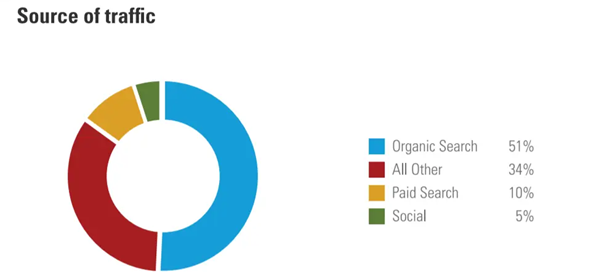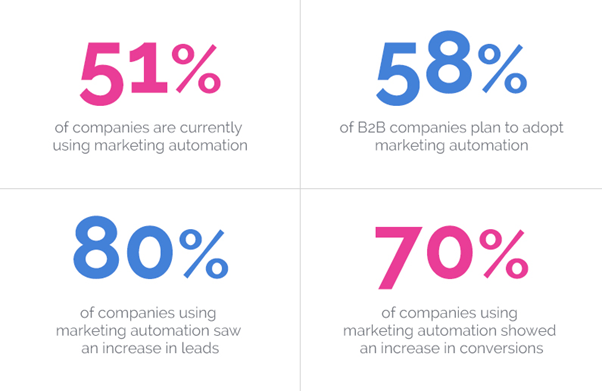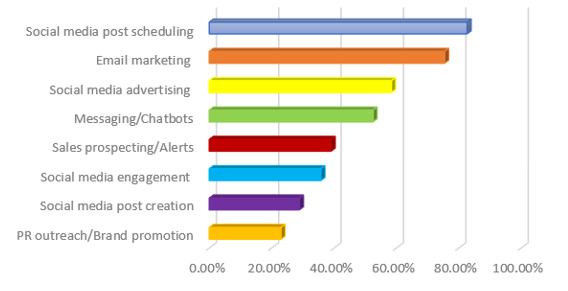
Business automation tools are quickly growing in popularity. From automated testing software, to accounting and bookkeeping automation,the computerized handling of repetitive tasks has transformed the way businesses operate on a daily basis.
It comes as no surprise that marketing – arguably one of the most time-consuming and repetitive parts of running a business – has been revolutionized by automation. Just look at these figures below.
Marketing automation simplifies the process of generating leads, analyzing lead behavior, managing email/social media marketing tasks, and more.
For small businesses in particular, it is invaluable to lead nurturing and customer retention efforts, providing you with the data (and free time) needed to scale your business.
Other benefits of market automation for small businesses include:
- No geographical restrictions: cloud computing automation means that employers can log into market automation software both in and out of the office
- Provides a data-driven framework to predict and measure the success of campaigns
- Boosts efficiency and productivity: studies show a productivity boost of 20%!
- Allows more free time to dedicate to other areas of your business
- Creates lucrative internal RPA career possibilities
Types of Automation
Before we explore exactly how to maximize market automation for small businesses, let’s take a quick look at popular ways to implement it.
Email Automation
Email automation software automatically sends your pre-written emails to contacts based on certain triggers or time frames set by you. It is invaluable to your email marketing strategy because it simplifies the drip campaign process, ensuring that your emails are sent regardless of whether you are at your screen.
Here are some of the ways that you can use email automation:
- Subscriber welcome email series
- Product/blog updates
- Tutorials or how-to emails based on certain purchases
- Lead nurturing emails
- Reminders
- Feedback forms/surveys
Automated Lead Scoring
Automated lead scoring involves assigning a number to a lead as an indicator of how likely they are to become a customer. Numbers are assigned based on a variety of attributes, most commonly things like engagement, demographics and online behaviors. Leads with higher scores are then prioritized by sales and marketing teams.
Automated lead scoring is a popular strategy because once your model is established, it becomes much clearer which leads are the most valuable to your business.
While lead scoring is great for nurturing leads and increasing conversions, a poor lead scoring model can severely harm your business.
Social Media Automation
Using automation for social media is one of the most popular and successful ways to utilize automation strategies, as manually managing social media accounts can be very time-consuming. Automation prevents you from having to log on and post multiple times a day across different channels.
In fact, in their State of Marketing Automation Survey 2019, SocialMediaToday found that social media post scheduling was determined to be the most useful automation process for marketers, with social media advertising coming in at third place.
Here are some of the ways that you can use social media automation:
- Queue and schedule posts to go live at your peak engagement hours (some schedulers will even calculate this for you)
- Respond to messages via a chatbot
- Recycle evergreen content
- Monitor hashtags, trends, brand mentions, etc
When used properly, automation can streamline your marketing process. Here are 7 tips to maximize market automation for small businesses.
1. Have a clear strategy in place
While implementing automation does relieve you of some work, it is only as effective as the creative strategy behind it. In order to create successful campaigns, it is essential to establish a clear strategy and measurable goals, especially if you’re a start-up or small business.
Identify measurable goals
Always have clear, quantifiable goals in sight. For example, maybe you’re looking to increase your social media engagement levels or email subscribers. Maybe you’re focused on customer retention or simply increasing purchases. Whatever the case, identifying your goals will cement your strategy and allow you to optimize your campaigns accordingly.
Pick your software wisely
There are a vast amount of marketing automation tools to choose from. Pick the software that aligns most accurately with your specific goals for a positive return on investment (ROI).
Don’t dive into the trap of automating everything straight away
Effective marketing automation strategy derives from data collected and analyzed over time. If you automate everything without this fundamental research, you run the risk of repeating campaigns that are destined to fail. That’s a lot of money thrown at a problem, for very little result.
So, start small and progress slowly. If you’re struggling with strategy, a robotic process automation assessment can help you map out your path to RPA success.
2. Build an authentic contact list
While it might be tempting to just buy a ready-made email list, it is actually one of the most damaging things that a small business can do. Why?
Because although buying a list might give you those initial numbers, it won’t give you conversions, engagement, or customer loyalty. Even worse, you could potentially find yourself in legal trouble for breaking GDPR regulations due to lack of explicit consent.
By building your list organically, you are ensuring that the majority of people on it are consenting and genuinely interested potential customers. That way, you are much more likely to generate quality leads and conversions, as well as build a loyal customer foundation and maintain a trustworthy reputation.
3. Create good content
A lot of your marketing automation efforts will be pointless if the content you put out isn’t interesting. Anything you share via your emails or social media channels needs to be high-quality, engaging, and informative. That way, people are more likely to click on your links and travel further down your sales funnel.
It’s useful to bear in mind the importance of creating SEO-friendly content. SEO is the driver of organic traffic, making it one of the most powerful marketing tactics to date.
 Image Source
Image Source
Failing to utilize SEO effectively can have a disastrous effect on your business, even if you’ve implemented the best marketing strategies. If you struggle to get to grips with SEO, consider taking an online course, or enlisting the help of an agency.
Remember: make sure to pick an agency that specializes in your field. For example, if you’re a B2B company selling a subscription-based software service, you would seek the assistance of a B2B SaaS marketing agency.
4. Segment your lists and personalize emails
Segmenting your contact list into categories based on things like demographic, interest, and behavior is an efficient way to make sure that you are targeting the right customers with the right products at exactly the right times.
Segmentation is especially useful for drip campaigns because it ensures that only selected customers receive multiple automated emails. If a customer isn’t interested in the subject of your drip campaign, they are much more likely to unsubscribe due to the influx of unwanted emails.
If you really want to excel with your segmented campaigns and increase your email response rate, then personalizing your emails is a must.
Personalization is extremely important for lead nurturing because people want to feel as though they can connect with your company on a human level rather than a corporate one. So, create catchy subject lines. Address people by their names. Use emojis. Write as though you are talking to one customer personally, rather than sending a generic mass email. It makes all the difference.
5. Make Time For Training
In order to successfully set up and manage your chosen marketing automation software, it’s a good idea to undergo some training.
Jumping into your new software without prior knowledge can very easily result in mistakes being made or features being misused. Also, bear in mind that using these automation tools will become a fundamental part of your marketing team’s workday, transforming their schedules and refocusing their interests. Providing training will help you and your team to use them to their fullest, leading to better results in the long run.
6. Routinely analyze results
Not all automation methods are suitable – or even necessary – for every kind of campaign, which is why it’s important to keep track of your progress to see what is or isn’t working for you. Pay close attention to things like CTRs, conversions, unsubscribe rates and how many people are actually opening your emails, because these figures will be the biggest indicators of your success.
If you are a business that already deals with copious amounts of data, routinely collecting and interpreting relevant customer data for analysis may also become a laborious task. Fortunately, you can also automate the extraction of unstructured / semi-structured data into usable data via intelligent document solutions.
7. Be careful not to over-automate customer interactions
Marketing automation and customer service automation often go hand-in-hand – and it’s easy to see why. After all, chatbots do not need to memorize names or numbers, nor do they struggle to memorize the nato phonetic alphabet. They can provide customer support 24/7 and never, ever sound grumpy on a Monday morning.
However, relying too heavily on automation can run the risk of distancing your customers if they don’t feel connected to your brand on a human level. In fact, only 28% of customers report being able to resolve their issues via a chatbot.
So, set limits on how much of your interactions with customers are automated. For example, if somebody asks for help or files a complaint, send an auto-reply for confirmation but follow up with a genuine, personalized response to their problem. If you have a chat bot, make sure it has the option to escalate to a member of your team if needed. Think of it as a way to enhance, rather than replace, your customer service team.
What next?
Automation isn’t a ‘set it up and forget about it’ venture. It requires a lot of strategy, optimization and repeated analysis to achieve maximum results. Whether you’re automating SEO tasks or lead generation, it’s important to do the research.With all the benefits that it has to offer, market automation is certainly worth it for small businesses, especially those looking to increase customer retention, engagement and conversions.
With AI constantly evolving, the future is looking brighter than ever for automation technology. Now is definitely the time to kickstart your automation journey and reap the benefits for your business.
3499 Views















